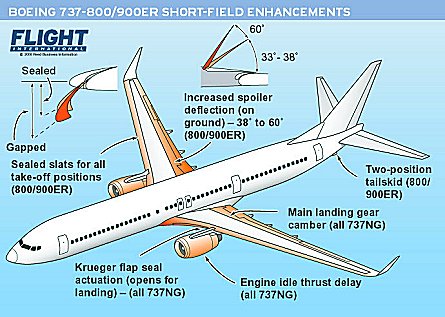Boeing expects to begin flight tests in January of a short-field performance enhancement package for the 737 Next Generation family, which is expected to markedly reduce take-off and landing runs or significantly increase payload performance.
Launched initially to enable the Brazilian carrier GOL to operate larger 737-800s into the restricted 1,465m (4,800ft)-long runway of Rio de Janeiro’s Santos Dumont airport, various elements of the package are expected to offer benefits across the entire range of Next Generation models, says 737 chief project engineer Mike Delaney.

The improvements could apply to operators flying into “places like Florence, London City, the Faroe Islands and several areas in Japan”, says Delaney.
The enhancement package consists of elements that can be applied to the longer-body -800/900ER models as well as a wider set of improvements that can be offered for other family members. Specific to the -800/900ER are sealed slats for all take-off flap positions, and a two-position tailskid. On current aircraft, the slats are sealed for take-off flap positions 1° and 5°, and are gapped for 10°, 15°, 25° and over. The change will see the sealed positions extend through 25° flap.
Next Generation generic configuration changes include Krueger flap seal actuation to allow the device to be “left sealed for take-off and up out of the way [open] for approach and landing,” says Delaney.
Flight spoiler deflection on the ground will also be increased from 30°, to match the maximum 60° of the ground spoilers. The operation of the flight spoilers in normal flight will be unchanged, he says. “But when it lands all the spoilers will come up to a nominal 60° throw for greater braking performance.”
Another subtle change across all models will be a reduction in the camber, or “splay” of the main landing gear. “We’ve brought it in by just over 1°, which increases the uniformity of braking across all four brakes and will help tyre [wear] issues we’ve seen across the fleet. It’s a maintenance benefit.”
Also changing will be the engine idle-thrust delay time, which is being reduced from 5s to 2s. The change, effected through the CFM International CFM56-7B’s full authority digital engine control, will “bring forward idle thrust off the aircraft faster”, thereby helping shorten the landing roll.
The Krueger flap change is applicable to all models and will boost landing performance, as will the idle thrust delay change. The increased flight spoiler deflection, also applicable across all models, will improve both take-off and landing. The -800/900ER specific changes will boost take-off performance in the case of the leading-edge slat seal change, and landing performance in the case of the two-position tailskid.
Boeing expects the package to reduce the typical landing run of a winglet-equipped -800 by up to 100m, or increase the landing weight by as much as 4,730kg (10,400lb); while the take-off length could be reduced by more than 70m or the take-off weight performance boosted by more than 1,710kg.
The three-month flight-test effort is expected to run from late January through to late April, with the delivery of the first fully equipped aircraft due around mid-June 2006.
GUY NORRIS/LOS ANGELES
Source: Flight International
















